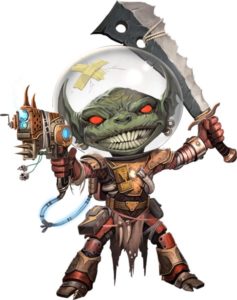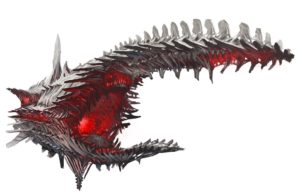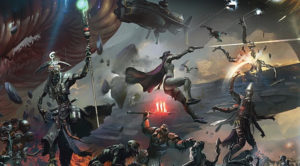Starfinder RPG — a pulp space opera / planetary romance RPG?
Posted by Rampant Coyote on December 5, 2017
 Over the Thanksgiving holiday, I finally got the chance to play the Starfinder RPG with my family. As a major fan of the Pathfinder system by Paizo, I was was pretty excited to try out their science fiction RPG.
Over the Thanksgiving holiday, I finally got the chance to play the Starfinder RPG with my family. As a major fan of the Pathfinder system by Paizo, I was was pretty excited to try out their science fiction RPG.
It took me a while to wrap my brain around the game. It was not quite what I expected. But once I finally figured it out, I realized it was something better. It is in no way at all a traditional science fiction RPG. There are many options for that, one of the most venerable being Traveller… in all its many rules system variations. Traveller is awesome. The new Star Wars RPG series by Fantasy Flight Games is also pretty cool. I recommend both. And that’s not even skimming the surface of what’s out there… those are just a couple of systems that I have played which have come to mind.
Starfinder isn’t a “me, too” space opera RPG. It charts a course in a completely different direction. I’ll start with the thing that took me aback at first: SPACE GOBLINS. And not just generic goblins, but full-on Paizo-style goblins, the clinically insane and often hysterically amusing little pests. Seriously? But the more I considered it, and the deeper I dug into the campaign world (universe?), the more I warmed up to the idea. I guess that was the thing I needed to shatter my preconceptions and really embrace the game on its own terms. 
So what is Starfinder? I kind of imagine it as a mixture of three ingredients:
- Pathfinder in space.
- Classic early-to-mid 20th century Pulp SF
- Comic Book / Anime / Manga Space Opera
Starfinder is not the game for playing in a Star Trek or Firefly type of universe. I mean, sure, you can probably force-fit a campaign with lots of restrictions and get it to be serviceable, but it is far from optimal for that. It’s the game for playing Guardians of the Galaxy, or for emulating John Carter, or something with a more Star Wars-ish flavor. It’s space where lasers go “pew pew” (complete with sound effects), where undead travel space inside ships resembling bizarre skeletal structures without life support systems, where gods and demons are real and terrifyingly powerful, where magic-wielding mystics fight side-by-side with blaster-wielding power-armored soldiers, and where there giant creatures might actually be found flying through space. It’s “science fantasy” unafraid to get a little weird for the sake of fun.
The second “ah-hah” moment I had was going through the default campaign materials. The campaign as presented is really focused on a single star system. Seriously? All of a galaxy to explore, and they are focusing on a single system and its planets? What gives?
Then I started studying the planets. There’s… the jungle-and-swamp filled world of Castrovel. And the dry, dying red planet of Akiton. The rings of Liavara. The many moons of the gas giant Bretheda…
Wait, what?
This is the solar system of the pulp SF writers, kinda. The planetary romances from the first half of the 20th century that imagined our solar system teeming with alien life and ancient mysteries. The designers borrowed these ideas, put them around a different star, added some new idea of their own (or borrowed from other sources), and went to town. Once I grasped this, I was (naturally) ecstatic.
 I think the plan going forward is that these worlds will not simply be the “planet of the week” from Star Trek, or the usual single-climate, single-themed planets of Star Wars, etc. The core rulebook talks about the variations in the planets, the different cities and what makes them unique, that kind of thing. In theory, it sounds like you could do the John Carter thing and have an entire campaign set on one planet.
I think the plan going forward is that these worlds will not simply be the “planet of the week” from Star Trek, or the usual single-climate, single-themed planets of Star Wars, etc. The core rulebook talks about the variations in the planets, the different cities and what makes them unique, that kind of thing. In theory, it sounds like you could do the John Carter thing and have an entire campaign set on one planet.
But wait, there’s more. While the core worlds are certainly central to the default campaign (and there’s a game-rule and in-game rationale for that), they do still have a full galaxy out there to explore, not to mention other dimensions / planes of existence, etc. There’s the whole Azlanti Star Empire, spanning numerous systems, with its gigantic star fleet and Aeon Guards encased in battle armor that deliberately makes them faceless … um… stormtroopers. A campaign set there might have a flavor much like a certain ridiculously popular science fiction franchise. There’s the civilization-devouring Swarm that harvests the DNA of the races it conquers and splices part of it into a new racial offshoot of its own. There are tons of possibilities for different kinds of campaign styles.
And yeah, as for character classes, you have a mix of magic and tech. Full-blown mystics, techno-mages, and the strange Solarions who wield tiny fragments of suns (or black holes) for weapons and armor. Like I said, it’s a bit “Pathfinder in Space.” You could exclude those parts to tailor the flavor to something more serious… but I think it’s more fun not to. That’s like excluding Rocket from Guardians of the Galaxy because a gun-happy humanoid raccoon is too over-the-top. The game is still pretty heavily influenced by Pathfinder (which was, in turn, a Dungeons & Dragons derivative). This means it’s heavily class-based and level-based. They did a good job of making the classes interesting with lots of options, so having two operatives in the party doesn’t make one of them feel superfluous. In fact, between race and racial abilities, the “theme” and its level-based abilities, the different options for each class (think of the sorcerer bloodlines in Pathfinder), and the pathfinder idea of “archetypes” built directly into and balanced with the game (but really reserved for future expansions), the “class based system” is pretty dang flexible. And of course, you still have the D20-based feats, skills, etc.
However, it does seem like they’ve tried to streamline things a bit from the 3rd edition days so making a character is a little bit less of a chore. I can’t exactly say how well they’ve pulled that off, just that it seems they’ve tried. If nothing else, it seems like they have cleaned up the exceptions to the rules a bit so that everything can proceed more systematically. They are also deprecating the use of random dice rolls in character generation, so that you are less likely to be stuck with a low-hit-point soldier because of some bad luck.
In the Alien Archive and similar third-party books, the game takes pains to make any reasonably balanced race that has enough free will to be a playable character *can* be a player character, and they always have sidebars for using them as a player race choice. In this game universe, humans are just a racial option. It’s intended to be full of all kinds of weird creatures as both PCs and NPCs. I like that.
 Combat has received a significant overhaul while still kinda-sorta keeping to the old Pathfinder / D20 rules. The extra attacks at every 5 points of base attack bonus rule is GONE. A character gets one attack per turn, unless they choose the full attack option, in which case they get two attacks at a -4 penalty (each). Of course, there are feats, racial abilities, item properties, and (I think) class abilities galore that change all that, but this really fixes up a particularly challenging power-scaling problem from the D20 rules. They’ve also done away with the free 5-foot move (‘adjustment’) from D20, but that’s much less of an issue when being denied the full attack isn’t nearly such a problem.
Combat has received a significant overhaul while still kinda-sorta keeping to the old Pathfinder / D20 rules. The extra attacks at every 5 points of base attack bonus rule is GONE. A character gets one attack per turn, unless they choose the full attack option, in which case they get two attacks at a -4 penalty (each). Of course, there are feats, racial abilities, item properties, and (I think) class abilities galore that change all that, but this really fixes up a particularly challenging power-scaling problem from the D20 rules. They’ve also done away with the free 5-foot move (‘adjustment’) from D20, but that’s much less of an issue when being denied the full attack isn’t nearly such a problem.
The game economy is… weird. Equipment has a tier rating, which is really only something used by gamemasters in the same way that the CR or encounter level would be used… more as a rule-of-thumb for the GM. Don’t reward 3rd level PCs with Level 20 Nanotube Carbon Skin Armor if you don’t want your game to become entirely imbalanced and very difficult to plan challenges around. Like 3E / Pathfinder, pricing is scaled based on a formula and reward schedule that should work out reasonably well if GMs stick with the “system” and don’t deviate too much. But it does mean that a Firefly-style campaign where your characters are always going to be on the ragged edge of solvency is tougher to work out with this system, and you won’t get as much rules help (and character classes may become more imbalanced as they level, etc.)
Starships are a whole different beast. It’s a problem child in any space opera system. The prices of giant starfaring vessels being what they should be, one really good salvage (or act of piracy) risks completely derailing a campaign. Starfinder deals with the problem by sidestepping it completely. It assumes the PCs have access to a starship (but readily notes this isn’t necessary). Now, how they have access to the starship is left to the campaign. Maybe it’s assigned to them by whatever agency they are working for. Maybe they are in hock up to their eyeballs for it. Maybe it’s inherited. Whatever the case, the game doesn’t have prices listed for starships. Instead, the party’s ship is assumed to be something of a member of the party and levels up with the average character level of the party. Whether this is through upgrades or reassignment or the party taking over a new ship they have salvaged and using money from selling their previous ship to get it fixed up, or use the salvage to upgrade their existing ship, whatever. As the party levels up, they get additional Build Points and access to higher tier equipment. It takes some of the thrill out of the big salvage score, which basically turns it all into little more than a story bonus in the hands of the GM, with only the in-game bonuses he or she offers.
By the same token, it offers flexibility for the game. Whether the party is a military unit receiving new ship assignments based on their prestige, privateers going after prize money for captured ships, mercenaries fighting bad guys for cash, mercenaries, entrepreneurs, or whatever, the abstract system leaves those kinds of details to the GM. It’s adaptable, and you don’t have to worry about the party selling their ship for the best battle-armor and plasma rifles and magical rings that money can buy.
The game rules do have a strong combat-focus, which makes sense. The skill system and role-playing can pretty much handle everything else, without too many problems. One advantage of its roots in Pathfinder is that the game assumes the GM will borrow freely from Pathfinder source material, especially monsters from the Beastiaries. Why not? It does offer some cautions and advice for dealing with more persistent elements crossing over between the games, especially magic, and noting some ways in which the systems are balanced differently and how that might effect CR or the value of certain equipment.
All-in-all… I think I’m a fan. They’ve pushed themselves in a different direction on the Space Opera front, but not so far that you can’t reasonably simulate a good chunk of popular (and classic) space-opera-esque science fiction (or “science fantasy” for some). If you can’t stand the idea of mixing fantasy and science fiction, you might have a problem with it. If you don’t like class-and-level-based RPG gaming, this is also probably not your game. Personally, I like what they did with the rules, and I don’t mind that they limited the compatibility with Pathfinder with their changes. I really like the direction they seem to have gone with the default campaign setting. I look forward to seeing it more fleshed out in the future if they maintain what seems to be the current vision. I hope to have a chance to play a campaign in this system soon.
Filed Under: Dice & Paper - Comments: Read the First Comment
Cuthalion said,
This actually has me much more interested than I was! I’ve had difficulties running or playing Pathfinder, usually involving reviewing huge lists of options built up over the years of supplements or trouble figuring out various rules interactions. Maybe Starfinder will still have those problems, but it does sound very fun.